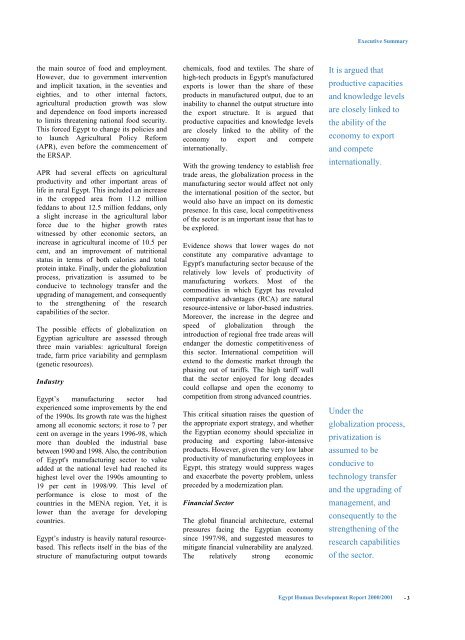English - Human Development Reports - United Nations ...
English - Human Development Reports - United Nations ...
English - Human Development Reports - United Nations ...
Create successful ePaper yourself
Turn your PDF publications into a flip-book with our unique Google optimized e-Paper software.
Executive Summarythe main source of food and employment.However, due to government interventionand implicit taxation, in the seventies andeighties, and to other internal factors,agricultural production growth was slowand dependence on food imports increasedto limits threatening national food security.This forced Egypt to change its policies andto launch Agricultural Policy Reform(APR), even before the commencement ofthe ERSAP.APR had several effects on agriculturalproductivity and other important areas oflife in rural Egypt. This included an increasein the cropped area from 11.2 millionfeddans to about 12.5 million feddans, onlya slight increase in the agricultural laborforce due to the higher growth rateswitnessed by other economic sectors, anincrease in agricultural income of 10.5 percent, and an improvement of nutritionalstatus in terms of both calories and totalprotein intake. Finally, under the globalizationprocess, privatization is assumed to beconducive to technology transfer and theupgrading of management, and consequentlyto the strengthening of the researchcapabilities of the sector.The possible effects of globalization onEgyptian agriculture are assessed throughthree main variables: agricultural foreigntrade, farm price variability and germplasm(genetic resources).IndustryEgypt’s manufacturing sector hadexperienced some improvements by the endof the 1990s. Its growth rate was the highestamong all economic sectors; it rose to 7 percent on average in the years 1996-98, whichmore than doubled the industrial basebetween 1990 and 1998. Also, the contributionof Egypt's manufacturing sector to valueadded at the national level had reached itshighest level over the 1990s amounting to19 per cent in 1998/99. This level ofperformance is close to most of thecountries in the MENA region. Yet, it islower than the average for developingcountries.Egypt’s industry is heavily natural resourcebased.This reflects itself in the bias of thestructure of manufacturing output towardschemicals, food and textiles. The share ofhigh-tech products in Egypt's manufacturedexports is lower than the share of theseproducts in manufactured output, due to aninability to channel the output structure intothe export structure. It is argued thatproductive capacities and knowledge levelsare closely linked to the ability of theeconomy to export and competeinternationally.With the growing tendency to establish freetrade areas, the globalization process in themanufacturing sector would affect not onlythe international position of the sector, butwould also have an impact on its domesticpresence. In this case, local competitivenessof the sector is an important issue that has tobe explored.Evidence shows that lower wages do notconstitute any comparative advantage toEgypt's manufacturing sector because of therelatively low levels of productivity ofmanufacturing workers. Most of thecommodities in which Egypt has revealedcomparative advantages (RCA) are naturalresource-intensive or labor-based industries.Moreover, the increase in the degree andspeed of globalization through theintroduction of regional free trade areas willendanger the domestic competitiveness ofthis sector. International competition willextend to the domestic market through thephasing out of tariffs. The high tariff wallthat the sector enjoyed for long decadescould collapse and open the economy tocompetition from strong advanced countries.This critical situation raises the question ofthe appropriate export strategy, and whetherthe Egyptian economy should specialize inproducing and exporting labor-intensiveproducts. However, given the very low laborproductivity of manufacturing employees inEgypt, this strategy would suppress wagesand exacerbate the poverty problem, unlesspreceded by a modernization plan.Financial SectorThe global financial architecture, externalpressures facing the Egyptian economysince 1997/98, and suggested measures tomitigate financial vulnerability are analyzed.The relatively strong economicIt is argued thatproductive capacitiesand knowledge levelsare closely linked tothe ability of theeconomy to exportand competeinternationally.Under theglobalization process,privatization isassumed to beconducive totechnology transferand the upgrading ofmanagement, andconsequently to thestrengthening of theresearch capabilitiesof the sector.Egypt <strong>Human</strong> <strong>Development</strong> Report 2000/2001 - 3
















